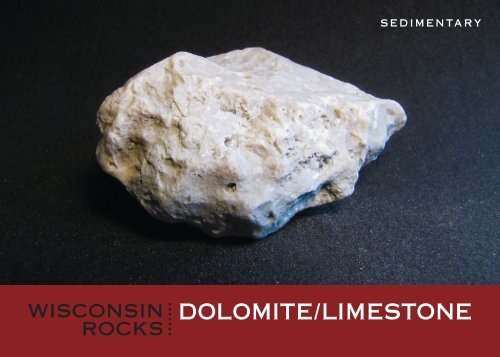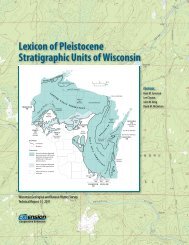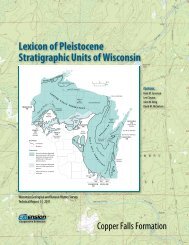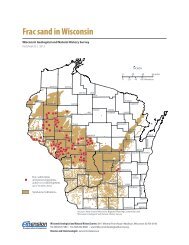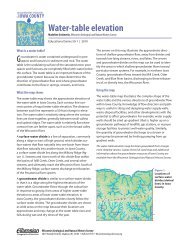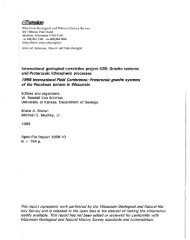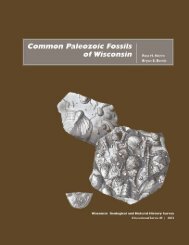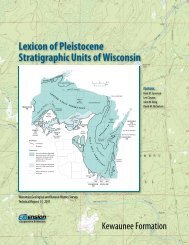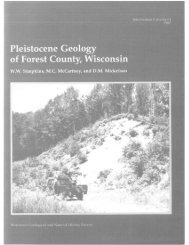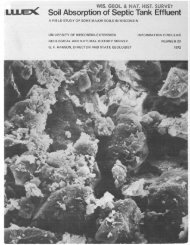(and a fossil), set of six trading cards - Wisconsin Geological and ...
(and a fossil), set of six trading cards - Wisconsin Geological and ...
(and a fossil), set of six trading cards - Wisconsin Geological and ...
You also want an ePaper? Increase the reach of your titles
YUMPU automatically turns print PDFs into web optimized ePapers that Google loves.
wisconsin<br />
rocks<br />
DOLOMITE/LIMESTONE<br />
.......<br />
SEDIMENTARY
1<br />
wisconsin<br />
rocks<br />
......<br />
Age range 385–490 million years old<br />
How the rock Limestone, a sedimentary rock, formed from the shells <strong>of</strong> marine<br />
was formed animals <strong>and</strong> by precipitation <strong>of</strong> calcium carbonate on the ocean floor.<br />
With time, these materials hardened into limestone. Magnesium<br />
in seawater moved through the limestone to replace some <strong>of</strong> the<br />
calcium to form dolomite. Dolomite is also known as dolostone.<br />
Did you<br />
know?<br />
DOLOMITE/LIMESTONE<br />
Limestone powder is added to toothpaste to scrub teeth clean.<br />
The ancient Egyptian pyramids were made <strong>of</strong> limestone.<br />
Most <strong>Wisconsin</strong> <strong>fossil</strong>s are found in this kind <strong>of</strong> rock.<br />
Marble is metamorphosed from limestone <strong>and</strong> dolomite.<br />
<strong>Wisconsin</strong> <strong>Geological</strong> & Natural History Survey n University <strong>of</strong> <strong>Wisconsin</strong>–Extension<br />
www.wisconsingeologicalsurvey.org<br />
ES054-01 | 2013
wisconsin<br />
rocks<br />
GRANITE<br />
.......<br />
IGNEOUS
2<br />
wisconsin<br />
rocks<br />
......<br />
Age range 1,000–2,700 million years old<br />
How the rock Granite, an igneous rock, forms when magma, rising from deep inside<br />
was formed the earth, cools <strong>and</strong> slowly solidifies below ground. Granite is mostly<br />
made <strong>of</strong> crystals <strong>of</strong> three rock-forming minerals. The glassy-looking<br />
mineral is quartz. The mineral that gives this granite its ruby-red color<br />
is feldspar. And the black specks are small crystals <strong>of</strong> biotite, a dark<br />
mica mineral.<br />
Did you<br />
know?<br />
GRANITE<br />
Granite is so tough it can’t be scratched with a knife or nail.<br />
Granite is used for kitchen counters <strong>and</strong> building stone.<br />
The tomb <strong>of</strong> Ulysses S. Grant is made <strong>of</strong> <strong>Wisconsin</strong> red granite.<br />
Red granite became the <strong>of</strong>ficial state rock <strong>of</strong> <strong>Wisconsin</strong> in 1971.<br />
<strong>Wisconsin</strong> <strong>Geological</strong> & Natural History Survey n University <strong>of</strong> <strong>Wisconsin</strong>–Extension<br />
www.wisconsingeologicalsurvey.org<br />
ES054-02 | 2013
wisconsin<br />
rocks<br />
.......<br />
.......<br />
QUARTZITE<br />
METAMORPHIC
3<br />
wisconsin<br />
rocks<br />
......<br />
Age range 1,700–1,900 million years old<br />
How the rock Quartzite is a metamorphic rock that started out as s<strong>and</strong>stone.<br />
was formed Intense heat <strong>and</strong> pressure during deep burial changed the rock to<br />
quartzite by fusing the s<strong>and</strong> grains together.<br />
Did you<br />
know?<br />
QUARTZITE<br />
Quartzite rings like a bell when hit with a hammer.<br />
<strong>Wisconsin</strong>’s Baraboo quartzite was once part <strong>of</strong> an<br />
ancient mountain range.<br />
Quartzite is one <strong>of</strong> <strong>Wisconsin</strong>’s most durable rocks, which is<br />
why it’s used to line the beds <strong>of</strong> many railroad tracks.<br />
<strong>Wisconsin</strong> <strong>Geological</strong> & Natural History Survey n University <strong>of</strong> <strong>Wisconsin</strong>–Extension<br />
www.wisconsingeologicalsurvey.org<br />
ES054-03 | 2013
wisconsin<br />
rocks<br />
SANDSTONE<br />
.......<br />
SEDIMENTARY
4<br />
wisconsin<br />
rocks<br />
......<br />
Age range 460–500 million years old<br />
How the rock S<strong>and</strong>stone, a sedimentary rock, started out as loose s<strong>and</strong> in dunes <strong>and</strong><br />
was formed on beaches. As the s<strong>and</strong> was buried beneath thick layers <strong>of</strong> sediment,<br />
the grains were pushed closely together. They were later cemented in<br />
place by minerals to become s<strong>and</strong>stone.<br />
Did you<br />
know?<br />
SANDSTONE<br />
Silicon chips in computers are manufactured from<br />
highly purified s<strong>and</strong>stone.<br />
Crushed s<strong>and</strong>stone is melted to make window glass.<br />
Statues <strong>and</strong> tombstones have been carved from s<strong>and</strong>stone.<br />
<strong>Wisconsin</strong> <strong>Geological</strong> & Natural History Survey n University <strong>of</strong> <strong>Wisconsin</strong>–Extension<br />
www.wisconsingeologicalsurvey.org<br />
ES054-04 | 2013
wisconsin<br />
rocks<br />
SHALE<br />
.......<br />
SEDIMENTARY
5<br />
wisconsin<br />
rocks<br />
......<br />
Age range 360–500 million years old<br />
How the rock Shale, a sedimentary rock, is made <strong>of</strong> small, sheet-like clay particles.<br />
was formed The particles remain suspended in fast-moving streams <strong>and</strong> rivers,<br />
<strong>set</strong>tling out in the quiet water <strong>of</strong> lagoons, lakes, <strong>and</strong> deep oceans.<br />
The clay becomes buried <strong>and</strong> is compacted into the thinly layered<br />
rock we call shale.<br />
Did you<br />
know?<br />
SHALE<br />
Shale is s<strong>of</strong>t enough it can be cut with a knife.<br />
Shale is ground up <strong>and</strong> used to make cat litter.<br />
Terra-cotta garden pots, bricks, <strong>and</strong> tile are made <strong>of</strong> shale.<br />
Oil <strong>and</strong> gas can be found in shale, but not in <strong>Wisconsin</strong>.<br />
<strong>Wisconsin</strong> <strong>Geological</strong> & Natural History Survey n University <strong>of</strong> <strong>Wisconsin</strong>–Extension<br />
www.wisconsingeologicalsurvey.org<br />
ES054-05 | 2013
wisconsin<br />
<strong>fossil</strong>s<br />
TRILOBITE<br />
.......
6<br />
wisconsin<br />
<strong>fossil</strong>s<br />
TRILOBITE<br />
......<br />
Age range 360–500 million years old<br />
About the Trilobites (TRY-luh-bites), distant relatives <strong>of</strong> spiders <strong>and</strong> horseshoe<br />
<strong>fossil</strong> crabs, lived in the seas that once covered <strong>Wisconsin</strong>. Most species were<br />
small, 1 to 2 inches long, but some grew to 2 feet. They had hard shells<br />
that they shed as they grew. Their shells were divided into three ridges<br />
(tri-lobes) along the length <strong>of</strong> their body, giving them their name.<br />
Did you<br />
know?<br />
They breathed through gills attached to their legs.<br />
Trilobites are the only animals to have eyes made <strong>of</strong> crystals.<br />
One trilobite could leave behind multiple shells that<br />
could later become <strong>fossil</strong>s.<br />
A trilobite was named the state <strong>fossil</strong> in 1985.<br />
<strong>Wisconsin</strong> <strong>Geological</strong> & Natural History Survey n University <strong>of</strong> <strong>Wisconsin</strong>–Extension<br />
www.wisconsingeologicalsurvey.org<br />
ES054-06 | 2013


